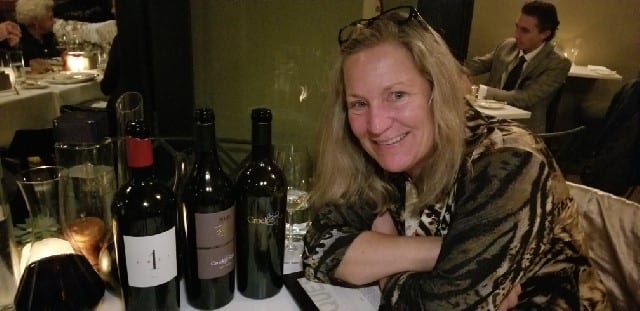
26 Apr Pam Starr: Driven by terroir with a craving for Cabernet
This story originally appeared in the Napa Valley Register.
“When I want to fill my soul, I drink Cabernet Sauvignon. It is a wine with both spirit and soul. It talks about where it comes from. As I put my nose in the glass, the aromas unfold. The palate entices as it unfolds. Fruit flavors, herbs, earth, tannin and acid, Cabernet Sauvignon gives a full-bodied soul bursting presentation.”
This is how winemaker Pam Starr described her beloved Cabernet Sauvignon as we were enjoying glasses of wine over dinner.
As much as she loves Cabernet, even more important to her is terroir.
Starr was raised in Palos Verdes in Southern California. Her father, a surgeon, and mother, a nurse, are originally from mid-west Canada and were not wine drinkers. But her upbringing is what led her to wine.
A product of multi-influences, Starr described her childhood as a “hands-in-the-dirt upbringing” where she and her three sisters would pick flowers and make their own perfume.
Athletic with a penchant for math and science, Starr went to UC Davis and studied fermentation science. She also took a job as a flavor technician at a local spice company in Sacramento and worked with spices ranging from bratwurst to pizza sauce.
After college, Starr took a job at Sonoma-Cutrer, a new winery at the time. Due to her time at the spice company, she had an innate sensory inclination and was skilled at putting words to smells. Her ability to describe things, coupled with her curiosity and enthusiasm, led to new opportunities.
She moved to San Luis Obispo and worked at Edna Valley Vineyards and then back to Sonoma to work at Carmenet Winery. Starr’s research in wine led to a trip to France in 1988. It was on this trip that the expression of terroir would become the focus on Starr’s work. “In France, I fell into the soil. I understood it.”
Starr returned to California with the intention to make wine that reflected the terroir. In 1991, she moved from Sonoma to Napa to work as the winemaker at Spottswoode.
New to Napa, Starr’s self-described ignorance of the region meant that she did not have any jaded impressions. Her innate curiosity had her asking questions and studying an old soils map from the 1950s. She followed the map across town and ended up in the Crocker Vineyard, owned by Charlie Crocker, a San Francisco investment banker and venture capitalist, who had purchased the James Dowdell Vineyard, family home and winery in 1971.
Starr contacted Charlie Crocker and in 1997 Crocker & Starr was born. The estate is 100 acres with 85 acres planted to red and white Bordeaux varieties.
Starr described how diverse the soil is within the organically farmed, vineyard. To demonstrate this, we opened three Cabernet Sauvignons. All three wines are 100 percent Cabernet Sauvignon and come from the same vineyard but due to climate, soil types and grape clones, each wine is unique and identifiable.
Crocker & Starr Cabernet Sauvignon “RLC” 2014
marks the inaugural release of RLC, the third estate Cabernet Sauvignon from the Crocker Vineyard. “RLC” represents the soil types—rock, loam and clay – that are found throughout the estate vineyard. The wine is juicy and approachable with aromas of cherry, cola, dried herbs and clay and a long finish. It is a wine that is ready to drink or can age and at only $65 per bottle is extremely affordable for Napa Cab.
Crocker & Starr 2014 Cabernet Sauvignon “Stone Place”
The first Cabernet produced from the property, the vines are more than 40 years old, the oldest vines on the property. The grapes come from Block #3, a five-acre section with three soil types. Light loam, small pebbles and bigger gravel underneath are in the western part, gravel and silt are in the center and a more “chocolate cake quality” with fewer pebbles are in the eastern part of the section.
The wine is about power and elegance. Aromas of black fruit, chocolate-covered cherries, violets and graphite float out of the glass. On the palate, chocolate-covered cherry persists, as well as notes of vanilla and tobacco. The wine is full bodied with elegant but ample tannins. Retail: $120
Crocker & Starr Cabernet Sauvignon “1 Post” 2013
Named after the San Francisco address of Charlie Crocker’s office where he and Pam first agreed to create Crocker & Starr, the grapes come from the most western section of the vineyard with well-draining light loam and pebble and a little clay. This section is where Starr has heirloom selections planted and every nine rows is a different rootstock and different clonal selection. Retail: $200
The wine is bright and the aromas of cherries, rose petals and graphite jump out of the glass. On the palate, the wine is plush with a balance of fruit, acid and tannins.
Each of the Crocker & Starr Cabernet Sauvignons is different and it is not because of the winemaker’s hand. As Starr explained, “the diversity lies under the ground where you cannot see it” and, as a result, her wines are driven by terroir.
Read the original story in the Napa Valley Register.
Discover more from Please The Palate
Subscribe to get the latest posts sent to your email.




